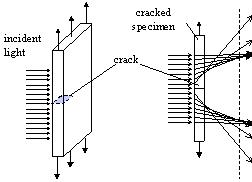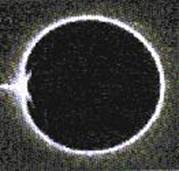
Basic principles:
The shadow optical method of caustics is an experimental technique which may be used in stress concentration problems and is particularly useful in the determination of stress intensity factors. The figure shows a transparent plate in tension containing a mode I crack. The singular stresses at the crack tip cause: (1) a reduction in thickness due to Poisson's Ratio effects (2) a change in the refractive index. If light is incident on the plate, both the thickness and the refractive index influence the light rays as the light passes through the plate. If a screen is placed at some distance from the specimen, the light pattern may be viewed. The light concentration is a caustic curve and the shadow area is known as the shadow spot. This diagram is in two dimensions. In reality the rays form a three dimensional envelope of light which is cut by a two dimensional screen or reference plane in order to view the caustic. This light deflection due to a stress field is the main principle behind the method of caustics. Since the shape and size of the caustic are caused by light deflections, which are due to the change in thickness and refractive index of the material; and these are due to the stress singularity; then the caustic shape is related directly to the singularity and therefore can be related to parameters such as the stress intensity factor. The method of caustics may be used in any engineering problem where a steep stress gradient exists. Examples of these include crack tip analysis, contact mechanics and stress concentrations around holes.


1. Theocaris, P S, Elastic Stress Intensity Factors Evaluated by Caustics, in G C Sih (ed.) Mechanics of Fracture, Vol. 7, Sijthoff and Noordhoff, (1981)
2. Theocaris, P S, Local Yielding Around a Crack Tip in Plexiglas, Jnl. of Applied Mechanics, 37, (1970), 409-415
3. Theocaris, P S and Razem, C I, Error Analysis in Evaluating Stress Intensity Factors by Reflected Caustics, Int. J. Mech. Sci., 23, (1981), 275-284
4. Kalthoff, J F, The Shadow Optical Method of Caustics, in A S Kobayashi (ed.), Handbook on Experimental Mechanics, Prentice Hall, Englewood Cliffs, New Jersey, (1987), 430-500
5. Beinert, J, and Kalthoff, J F, Experimental Determination of Dynamic Stress Intensity Factors by Shadow Patterns, in G C Sih (ed.) Mechanics of Fracture, Vol. 7, Sijthoff and Noordhoff, (1981)
6. Kitchin, R A and Patterson, E A, The practical use of virtual reflection caustics, Fat Fract. Eng Mat. Struct., 16, (6), (1993), 597-602
7. Carazo-Alvarez, J. and Patterson E.A. Study of contact loads by using image processing and non-linear regression with caustics. Proc of Int. Congress on Exp. Mech., (1995), 812-819.